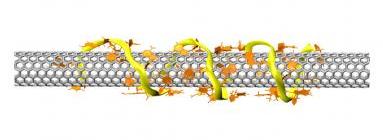National Institute of Standards and Technology (NIST) researchers described in their new paper the method of purifying the “armchair” type of carbon nanotubes using individual DNA strands.
The “armchair” type of single-wall carbon nanotubes are required to develop quantum wires that are used in wiring and allow electricity transmission for a long distance with minimum loss.
 "Wrapped up in their work: this molecular model shows a single-strand DNA molecule (yellow ribbon) coiled around an ""armchair"" carbon nanotube. Credit: Roxbury, Jagota/NIST
"Wrapped up in their work: this molecular model shows a single-strand DNA molecule (yellow ribbon) coiled around an ""armchair"" carbon nanotube. Credit: Roxbury, Jagota/NIST
Single-wall carbon nanotubes(CNT) are generally 1nm in diameter and in length, measure millions of nanometers. According to Xiaomin Tu, NIST researcher, normally carbon nanotubes show semiconductor properties, but few of them behave as metals. One special type of CNT referred to as “armchair” acts as a pure metal and is suitable for producing quantum wires.
Wires made from armchair carbon nanotubes are expected to have 10 times better conductivity of electricity than copper wires with minimum loss. However, the problems encountered by researchers in using them include production of completely pure armchair nanotube samples and the other is cloning them to enable mass production. The separation of a single particular spiral of nanotube from other clusters begins with a coating process so as to make them disperse in fluid because if they are left as such they would cluster together into a dark bunch.
Several agents such as DNA, proteins, and polymers have been utilized as dispersants. NIST researchers chose a DNA strand having specific affinity towards the preferred kind of nanotube. The previous research team experimented DNA strands that has affinity to carbon nanotubes of any semiconductor form. Whereas, this new research group has performed simple semiconductor-friendly DNA mutations to obtain a pattern that targets the metallic armchair form of nanotubes. After enveloping the desired nanotubes with the DNA, the researchers can detach them from the mix by applying standard chemistry methods, for example, the chromatography technique.